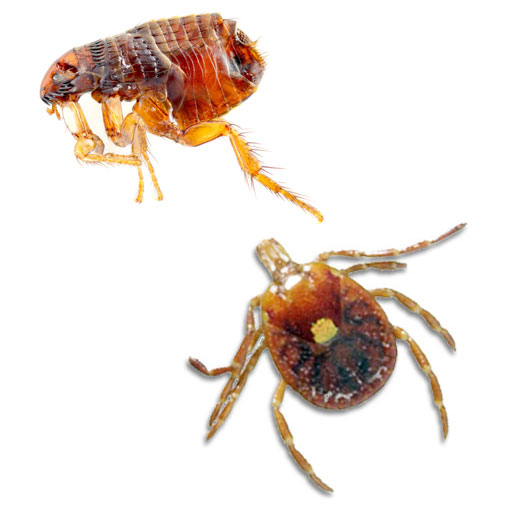Piroplasmosis (babesiosis) of dogs: symptoms, diagnosis, treatment
 There are two types of Babesia that can infect dogs:
There are two types of Babesia that can infect dogs:
Babesia canis and Babesia vogeli, which are also known as “big babesies”.
Babesia gibsoni and Theileria annae, similar to the Babesia microti species, are called “small babesies”.
Babesia infect erythrocytes in which the pathogen merozoites can be found. They are a pear-shaped, subspherical or rounded form of parasites, which can be arranged in pairs or singly in a cell.
Several species of Babesia have been described in various European countries: B. canis, B. vogeli, Theileria annae and B. gibsoni. They are a pear-shaped, subspherical or rounded form of parasites, which can be arranged in pairs or singly in a cell.
The preparatory period is short, lasts 4–20 days, and sometimes it can even be 1 or 2 days. The cost of treating a dog can be found in our price list.
Pathogenesis of the disease
Features of pathogenesis depend on several factors:
From the parasite: isolate virulence, whether primary infection or reinfection occurred, infectious dose.
From the host: young animals or those that have comorbidities, or those who have not previously had contact with this parasite when they enter an endemic area, are more susceptible to the disease, and the course of the disease in such animals is more severe.
The pathogenesis is the same for different types of Babesia:
Mechanical action: the destruction of red blood cells as a result of reproduction of trophozoites inside these cells. This leads to severe anemia (intravascular hemolysis), which persists during parasitemia.
Increased vascular permeability leads to the development of edema, vasodilation, hypotension and blood stasis, which leads to metabolic acidosis, which aggravates the course of the disease.
Red blood cells adhere to the endothelium of the blood vessels, causing the risk of thrombosis. The process is aggravated by the formation of immune complexes, which are deposited on the membrane of infected red blood cells and in some tissues.
Various clinical outcomes of the disease may develop, depending on the organ affected (liver, kidney, lung, skeletal muscle or heart, CNS).
Epidemiology
The seasonality of the disease is related to the climatic needs of its carriers – Ixodes ticks.
Main sources of infection
Babesiosis-infected ticks.
Sick animals.
Clinically healthy carriers that live in endemic areas.
Less common, babesiosis infection
Blood transfusion.
Surgical material.
Vertical transmission and transmission from dog to dog (infection of animals is described for B. gibsoni after being bitten by an infested dog).
Clinical signs (symptoms) of babesiosis dogs
Hyperthermia (above 41 ° C).
Asthenia, anorexia, weight loss.
Dehydration.
Gastrointestinal disorders (vomiting, diarrhea).
Hepatosplenomegaly, edema, ascites, jaundice, hemorrhages on the skin and mucous membranes, shortness of breath, pallor, muscle pain, paresis, ataxia.
Clinical and pathological changes: normochromic, normocytic, non-regenerative anemia, neutropenia, thrombocytopenia and hemoglobinuria.
The development of babesiosis symptoms (piroplasmosis)
The development of clinical signs depends on the type of parasite, the age of the animal, hygiene and nutritional conditions. The preparatory period is short, lasts 4–20 days, and sometimes it can even be 1 or 2 days.
In young animals, the clinical signs of babesiosis, as a rule, are acute, with a prepatented period of 4–6 days and a patent
a period of 7 to 10 days. Babesiosis can be fatal in this age group.
In adult animals, as a rule, the exacerbation of the chronic course of the disease occurs more often against the background of a weakened immune system.
The seasonality of the disease is related to the climatic needs of its carriers – Ixodes ticks.
Diagnosis of babesiosis (piroplasmosis) dogs
Clinical diagnosis is based on clinical examination data and laboratory results.
Specific Diagnostics
Blood smear test, molecular diagnostic methods and serological methods.
In stained blood smears: it is difficult to detect parasites due to the limited period of parasitemia. Thin smears prepared from peripheral blood (ear tip, capillary blood from the claw).
Molecular diagnosis: PCR, especially in cases of low parasitemia and to determine the type of Babesia.
Serological methods are not considered to be methods of choice due to cross-reactivity, mainly between B. canis and B. gibsoni. Cross-reactions can also occur between other types of babezium, which makes interpretation difficult. In addition, it is impossible to establish whether this is the result of a past invasion or a real one. In any case, these methods are convenient for examining samples during recovery and examining a sample that was re-taken in 3-4 weeks to evaluate seroconversion.



